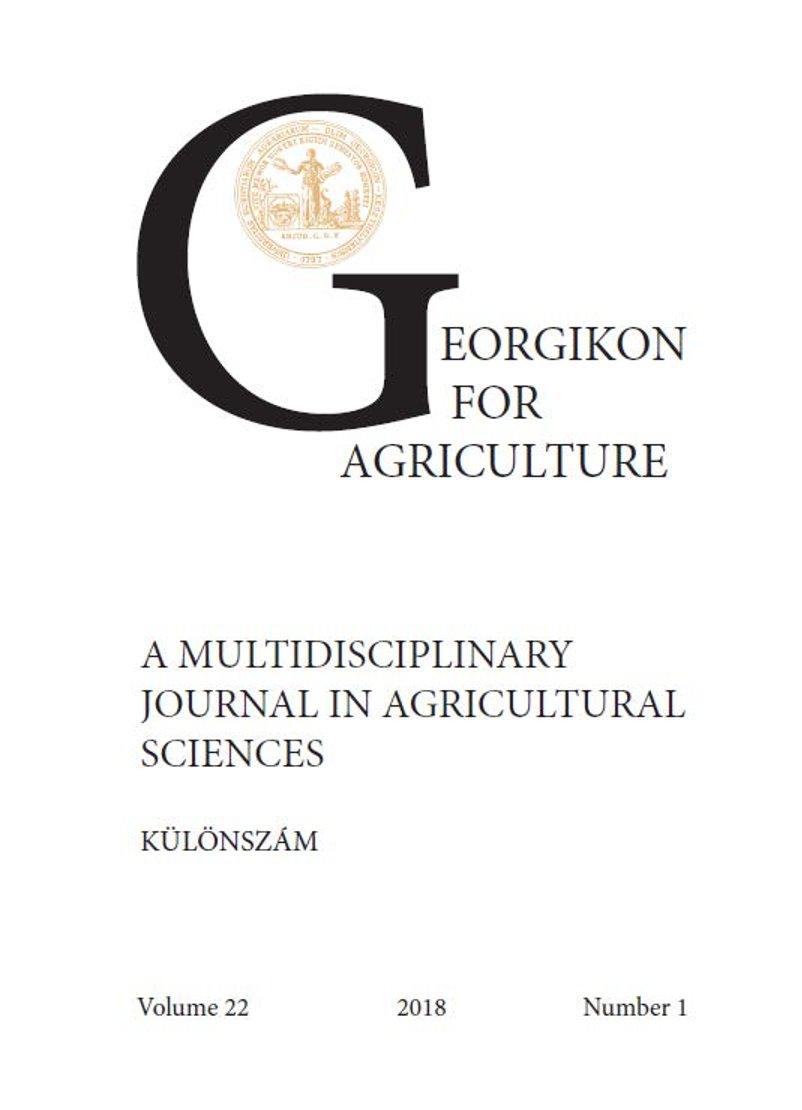Parlagfű ellenes bioherbicid vizsgálata
Kulcsszavak:
bioherbicid, allelokemikália, csírázásgátló, fotoszintézisgátló, gyomszabályozásAbsztrakt
Kísérleteinkkel célunk egy új, természetes gyomszabályozási módszer hatékonyságának értékelése volt. Tanulmányoztuk a gyomösszetételt a bioherbicid kipermetezése előtt és után. A készítmény totális és szelektív dózisának hatékonyságát vizsgáltuk: csírázásgátló hatását teszteltük termesztett köles magokon (Panicum miliaceum L.) laboratóriumi körülmények között; továbbá kisparcellás kísérleteket végeztünk a kecskeméti Knorr telep előtti és a Mécses utca parlagfűvel súlyosan fertőzött területein 2016-ban és 2017-ben; valamint vizsgáltuk hatásmechanizmusát fluoreszcencia indukcióval. Összefoglalóan megállapítható a laboratóriumi vizsgálatok eredményeiből, hogy a 3% és a 6% bioherbicidet tartalmazó oldat hatására szignifikánsan csökkent a köles magok csírázási erélye, jelentősnek bizonyult a bioherbicid csírázásgátló hatása. A kisparcellás vizsgálatok során a 6%os dózis totális gyomirtó hatást produkált, míg a 3%-os szelektív dózis megkímélte az egyszikű fűfajokat, miközben a parlagfüvet, betyárkórót elpusztította. Kitűnően mutatkozott a bioherbicid éven túli hatása is, hiszen a permetezés után egy évvel a területen csak kismértékben volt megtalálható a parlagfű, míg a természetes vegetáció helyreállt a területen. A bioherbicid fluoreszcencia indukcióval történő hatásmechanizmus vizsgálata során igazolódott fotoszintézisgátló hatása a PS II. rendszerben. Az általunk felhasznált készítmény allelokemikáliákat tartalmazó fotoszintézisgátló bioherbicid. A bioherbicid egy teljesen új találmány, hiszen ezen a területen főleg szintetikus herbicidek alkalmaznak, amelyek toxikusabbak, feldúsulhatnak a környezetben, aminek nyomán humánegészségügyi problémák okozói lehetnek. Általa a biológiai növényvédelemben termelők kaphatnának egy eszközt a gyomok irtására a mechanikai gyomirtáson kívül. Emellett egyszikű kultúráinkban érdemes volna tesztelni a bioherbicid szelektív dózisát, mert el tudjuk képzelni, hogy használható lehet kukoricában, búzában, hagymában a kétszikű gyomok irtására.
Hivatkozások
Hámori, B. 1995. A parlagfű Kecskeméten. Élet és Tudomány. 50 (38) 1214.
Kröel-Dulay, Gy., Csecserits, A., Szitár, K., Molnár, E., Szabó, R., Botta-Dukát, Z. 2011. A parlagfű mint egészséget veszélyeztető özöngyom elterjedésének ökológiai vonatkozásai. Magyar Tudomány. 172 (6) 658.
Novák, R. 2013. A parlagfű és egyéb allergén gyomnövények bemutatása. NÉBIH NTAI.
Pölös, E. 2015. szóbeli közlés
Pölös, E., Lehoczky E. 1988. Fluorescence properties of paraquat resistant Conyza leaves 109–114.
Solymosi, P., Gimesi, A. 1993. Gyomirtó hatású növényi kivonatok előállításának és alkalmazásának módszertana. Növényvédelem. 29 (8) 377–381.
Szentey, L., Tóth, Á., Dancza, I. 2004. Közös érdekünk, a parlagfűmentes Magyarország. Növény- és Talajvédelmi Központi Szolgálat. 3–27.
Letöltések
Megjelent
Folyóirat szám
Rovat
License
Copyright (c) 2018 Szabó Rita, Hegedűs Ariel Márk, Pölös Endre

This work is licensed under a Creative Commons Attribution-NonCommercial-NoDerivatives 4.0 International License.
The articel is under the Creative Commons 4.0 standard licenc: CC-BY-NC-ND-4.0. Under the following terms: You must give appropriate credit, provide a link to the license, and indicate if changes were made. You may do so in any reasonable manner, but not in any way that suggests the licensor endorses you or your use. You may not use the material for commercial purposes. If you remix, transform, or build upon the material, you may not distribute the modified material. You may not apply legal terms or technological measures that legally restrict others from doing anything the license permits.




 Georgikon for Agriculture
Georgikon for Agriculture